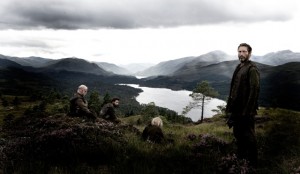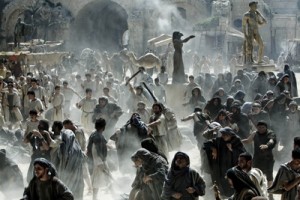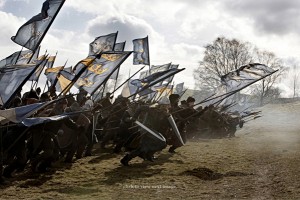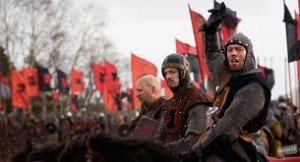(Dixon 2006) Time Team: Ep.171 ― Special: Buried by the Blitz
(Docter & Peterson 2009) Up
(Reis 1947) The Bachelor and the Bobby-Soxer Read more »
Category Archives: DL - Viewing 2010
FILMS OCTOBER-DECEMBER 2010
Sunday, October 3, 2010 — Some London Things
I spent my last day in the U.K., after taking care of some business matters, wih my friends Skye and Natasha, Canadians living in London.
Skye took me to visit Burrough Market, near London Bridge. Housed in a confusingly laid out Victorian structure, and milling with people, the market is a delightful chaos. There has been a market on the site, or at least nearby, for two thousand years. Burrough Market combines retail and wholesale functions, and there’s a certain amount of grime. This and the constant shouting of hawkers contrasts with the antiseptic quiet that pervades St. Lawrence Market in Toronto. We had some fine Persian pastries.
FILMS JULY-SEPT 2010
(Gilligan 2008) Breaking Bad: Ep.1 ― Pilot
(Twohy 2000) Pitch Black
(Mackendrick 1951) The Man in the White Suit Read more »
(Refn 2009) Valhalla Rising
 This is perhaps the oddest of the Medieval flics I’ve seen recently. Danish director Nicolas Winding Refn, best known for his Push series of thrillers, has created a relentlessly enigmatic, grim, and violent film set in the year 1000 AD. Read more »
This is perhaps the oddest of the Medieval flics I’ve seen recently. Danish director Nicolas Winding Refn, best known for his Push series of thrillers, has created a relentlessly enigmatic, grim, and violent film set in the year 1000 AD. Read more »
Friday, September 10, 2010 — Homo Cinematis
I’ve collected films for a long time. Long before it was possible to keep them as computer files, I was accumulating videotapes by the gross. I love films of all kinds, good and bad, and will watch all sorts of things that puzzle my friends. Why, for instance, would anyone in 2010 want to watch Spooks Run Wild, starring the East End Kids, or a 1959 Swedish film about extraterrestrials invading Lappland? Well, quite apart from the direct, childish pleasure this sort of thing gives me, I can pretend I have more serious, and presumably laudable reasons.
There’s an unfortunate habit among historians to talk about such and such a point in time as marking the beginning of “modernity” ― a point fixed, according to fashion, anywhere from the proof sheets of the Epic of Gilgamesh to the death of Kurt Cobain ― but there are two points in time where it can be convincingly argued that things did change for us quite drastically. After a mere thirty years of experiment, the technology of photography became widely available by the early 1850s. The sobering reality of the American Civil War leaps out at us from the photographs of Mathew Brady, and it wasn’t anything like war was depicted by the painter Jacques Louis David. Read more »
(Flinth 2007 & 2008) Arn the Knight Templar [and it’s Sequel]
This is an entertaining, but not overwhelming historical epic set in 12th Century Sweden, with some scenes in the Holy Land. It’s reputedly the most expensive Swedish film ever made, though it’s hard to see why.
FILMS APRIL-JUNE 2010
(Le Prince 1888) Roundhay Garden Scene
(Le Prince 1888) Traffic Crossing Leeds Bridge
(Edison 1889) Monkeyshines Read more »
FILMS JANUARY-MARCH 2010
(Gaup 1987) Ofelas
(Hughes 1999) Time Team: Ep.42 ― Kemerton, Worcestershire
(Semel 2006) House: Ep.33 ― Need to Know Read more »
(Amenábar 2009) Agora

 This excellent film has yet to find a North American distributor. It’s not hard to guess why. The film is a historically accurate portrayal of religious life in Alexandria in the early fifth century AD. The main character is Hypatia, the woman philosopher at the Museum of Alexandria, who was savagely murdered by a Christian mob. The film accurately portrays the city as engulfed in the brutal religious violence that accompanied the rise of Christianity in many parts of the Empire (The population of the city was divided between Christians, Pagans, and Jews, all sensitive to “insults” and determined to use force to control the city). Read more »
This excellent film has yet to find a North American distributor. It’s not hard to guess why. The film is a historically accurate portrayal of religious life in Alexandria in the early fifth century AD. The main character is Hypatia, the woman philosopher at the Museum of Alexandria, who was savagely murdered by a Christian mob. The film accurately portrays the city as engulfed in the brutal religious violence that accompanied the rise of Christianity in many parts of the Empire (The population of the city was divided between Christians, Pagans, and Jews, all sensitive to “insults” and determined to use force to control the city). Read more »
(Gaup 1987) Ofelas
 I watched this film in the original Sami language, without any subtitles, but it was not difficult to follow. The period is circa 1000 A.D., and the story portrays an encounter between the nomadic Sami (Lapps) who had inhabited the far north of Scandinavia since prehistoric times and the Chudes, another people who were more technologically advanced (they had crossbows). The encounter is seen from the Sami point of view, and all the dialogue is in Sami, a non-Indo-European language in the Finno-Ugric family. To this day, many Sami continue to live an arctic life-style of reindeer herding and hunting. There customs are so similar to those of the native people of Northern Canada that knowing the language was unnecessary for me. It was easy enough to guess what was happening and what people were saying. The acting is effective, especially that of 15-year-old Mikkel Gaup as the protagonist, a youth who works out a scheme to defeat the invaders and thus earns the position of shaman. The cinematography is crisply beautiful. This is basically another “resistance myth” — a bare bones realistic version of the tale told in fantastic form in Avatar. The title means “Pathfinder”.
I watched this film in the original Sami language, without any subtitles, but it was not difficult to follow. The period is circa 1000 A.D., and the story portrays an encounter between the nomadic Sami (Lapps) who had inhabited the far north of Scandinavia since prehistoric times and the Chudes, another people who were more technologically advanced (they had crossbows). The encounter is seen from the Sami point of view, and all the dialogue is in Sami, a non-Indo-European language in the Finno-Ugric family. To this day, many Sami continue to live an arctic life-style of reindeer herding and hunting. There customs are so similar to those of the native people of Northern Canada that knowing the language was unnecessary for me. It was easy enough to guess what was happening and what people were saying. The acting is effective, especially that of 15-year-old Mikkel Gaup as the protagonist, a youth who works out a scheme to defeat the invaders and thus earns the position of shaman. The cinematography is crisply beautiful. This is basically another “resistance myth” — a bare bones realistic version of the tale told in fantastic form in Avatar. The title means “Pathfinder”.


